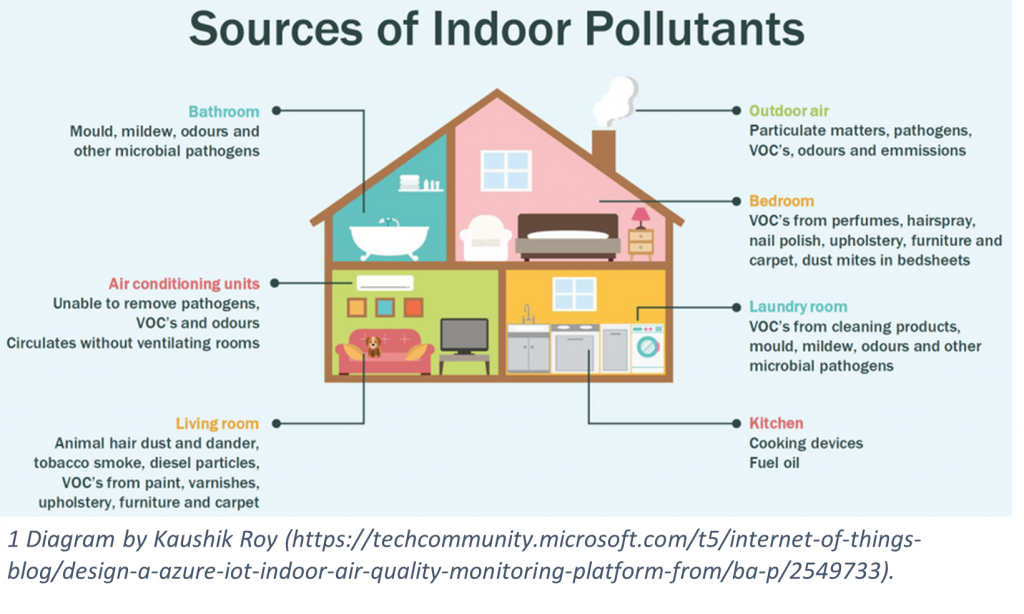Impact of Eco-Conscious Living Series: Indoor Air Quality
Just as you may think about the poor outdoor air quality on a smoky day or the smog that surrounds large cities, every building has its own body of air with varying degrees of quality and pollution that make up the indoor air quality (IAQ). IAQ is incredibly important for your own health and is, unfortunately, frequently under accounted for by mainstream building practices. It is, however, an attribute of eco-conscious building techniques for its impact on human and animal health, interlinked outcome of house longevity, and subsequent decrease in environmental footprint.
Taking a deeper dive into what IAQ actually is, IAQ can be anything from biological pollutants such as mold and mildew, bacteria, dust or pollen, to carbon monoxide or volatile organic compounds (VOC’s)5. Each pollutant effects humans, animals and the environment differently and the effects on humans can also vary depending on personal sensitivities. Exposure to just biological pollutant could lead to “skin irritation, sneezing, watery eyes, coughing, shortness of breath, dizziness, lethargy, fever, and digestive problems”1. Other pollutants, such as VOC’s, can cause more severe symptoms such as “eye, nose and throat irritation, headaches, loss of coordination and nausea, damage to liver, kidney and central nervous system,” with some VOC’s known or suspected to even cause cancer in humans or animals6. For information about all the individual indoor pollutants and their sources, visit https://www.epa.gov/indoor-air-quality-iaq/indoor-pollutants-and-sources.
Many of these pollutants are unavoidable as they can occur naturally, but we can take steps to reduce them to levels that will be less harmful or eliminate them almost entirely. If you hire TC Legend Homes, then before you even step into your house, we have already been working on increasing your home’s IAQ by using low toxicity products such as SIPs, low/zero VOC paints and finishes, low toxicity flooring and more. The SIPs we use eliminate the ozone depleting chemicals HCFCs and CFCs, as well as reduce moisture in between the walls that lead to mold growth.2 This, accompanied by the superior heating and ventilation installed, will set your home up for much healthier air. The next blog post in this series will discuss the details of ventilation and its impact.
Once moved into your new home, it is still important to take daily steps to maintain a healthier IAQ. Be sure to vacuum and dust regularly, clean fabric items frequently, reduce household clutter3, avoid harsh cleaning products, maintain a lower humidity level, repair leaks, run your exhaust fan during and after showering, maintain your ventilation system and change the filters frequently4.
Many eco-conscious building methods and results are interconnected, including IAQ, house longevity and environmental footprint. The nature of obtaining and maintaining good IAQ, means ensuring your home is being fixed of any issues which will result in the deterioration of your home and therefore cause indoor pollutants such as mold and mildew. Immediately fixing smaller issues that come up, like leaks or a filter in need of changing, will decrease the likelihood of the issues becoming so large that it is irreversible or will require more replacements to the system or surrounding area in the future. To this same note, upkeeping your home regularly and fixing issues as soon as they turn up, means using less resources in the long run, as replacement will be less frequent. As we know, using less resources helps to lower your overall carbon footprint. Moreover, maintaining good IAQ requires use of less toxic materials including those containing toxins and pollutants that are harmful to the environment such as greenhouse gases like VOCs or potent chemicals like pesticides. This in turn reduces the negative impact on the environment.
Taking all these steps to obtain and maintain your IAQ, will not only help you and your family’s health, but help reduce pollution outdoors and increase the longevity of your home.
Want to learn more about how smoke affects indoor air quality? Check out EPA Indoor Air Quality information and their recommendations for wildfire season HERE
Written by: Nicole Miller


Sources:
1“Biological Pollutants’ Impact on Indoor Air Quality.” United States Environmental Protection Agency (EPA), EPA.gov, https://www.epa.gov/indoor-air-quality-iaq/biological-pollutants-impact-indoor-air-quality. 2/10/2022.
2“Building With Sips Creates Healthier, More Comfortable Interiors.” Insulspan, https://www.insulspan.com/advantages/health-comfort/. 3/2/2022.
3“Easy ways you can improve indoor air quality.” Harvard Health Publishing, Harvard Medical School, https://www.health.harvard.edu/staying-healthy/easy-ways-you-can-improve-indoor-air-quality. 2/10/2022.
4“Improve Indoor Air Quality to Set Up a Healthier Home Environment.” AAFA, Asthma and Allergy Foundation of America, https://www.aafa.org/healthier-home-indoor-air-quality.aspx. 2/10/2022.
5“Indoor Pollutants and Sources.” United States Environmental Protection Agency (EPA), EPA.gov, https://www.epa.gov/indoor-air-quality-iaq/indoor-pollutants-and-sources. 2/10/2022.
6“Volatile Organic Compounds’ Impact on Indoor Air Quality.” United States Environmental Protection Agency (EPA), EPA.gov, https://www.epa.gov/indoor-air-quality-iaq/volatile-organic-compounds-impact-indoor-air-quality. 2/10/2022.


